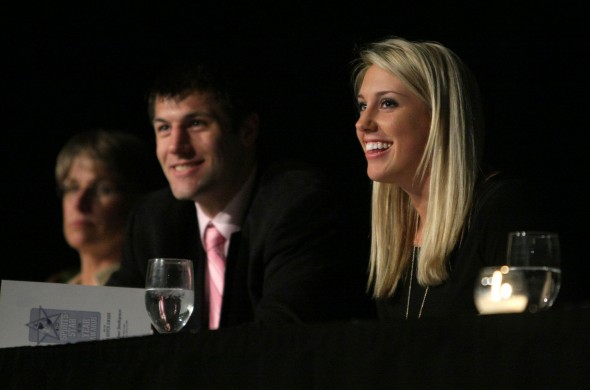
By David Eskenazi and Steve Rudman
When banquet goers arrived at the Westin Seattle Hotel for the Sports Star of the Year awards in January 2009 to select winners for 2008, most assumed they were attending the final edition of what, over seven decades, evolved into a civic institution. With the Post-Intelligencer awash in red ink and six weeks away from ceasing publication, even the newspaper assumed the worst.
“Barring an unexpected turn, the Sports Star tradition, born in 1935 as the brainchild of legendary P-I sports editor Royal Brougham, likely saw its final chapter,” the P-I wrote the day after the 74th ceremony. ”The P-I is up for sale and will cease publishing in the next few weeks unless a buyer is found.”
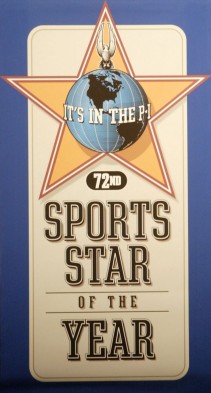
No buyer was found. The Post-Intelligencer, an editorial voice in the Pacific Northwest since 1869, published its final print edition March 17, 2009.
But Brougham’s 1936 creation did not cease just because the Post-Intelligencer presses stopped rolling.
Due to a timely intervention by the Seattle Sports Commission and Seattle Childrens Hospital, the Star of the Year awards continued (the 78th edition, sponsored by MTR Western, is Friday), sporting a new look, a new venue (Benaroya Hall) and new voting categories in the program format.
Perhaps heeding the words of 1970 Man of the Year winner Doris Brown Heritage, who said, “I’m always in favor of more awards,” the commission added a Professional Athlete of the Year category in order to give amateur athletes a better chance at recognition.
The commission also added a Sports Story of the Year category, in part to recognize team achievements, Executive of the Year, the Keith Jackson Award honoring a media achiever, the Royal Brougham Legend Award, the Paul Allen Award honoring community contributions, and the Seattle Children’s Inspirational Youth Award.
The commission instituted online voting, opening the process to anyone with access to a computer, not just to those in attendance.
Before the Seattle Sports Commission took over presentation of the awards, Mariners and Seahawks athletes dominated the voting, the Mariners winning in 2000, 2001 and 2002, and the Seahawks in 2003, 2005 and 2007.
The male side of the ballot produced two pleasant surprises: In 2004, voters opted for an amateur golfer, and in 2006 they came around to crowning a University of Washington basketball player for the first time in Man/Star of the Year history.
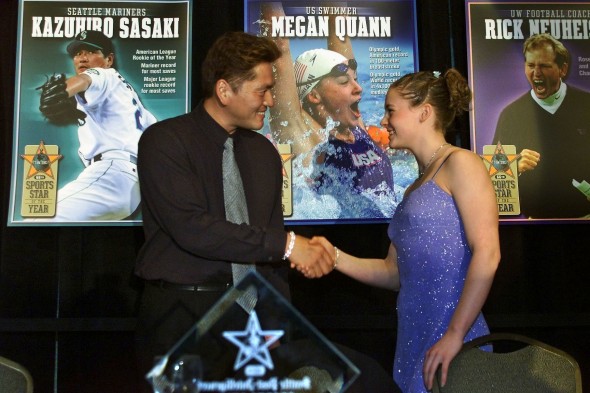
2000 / KAZUHIRO SASAKI, Baseball
2000 / MEAGAN QUANN, Swimming
Between 1935 and 1991, the University of Washington football team won six Rose Bowls following the 1959, 1960, 1977, 1981, 1990 and 1991 seasons. After each triumph, a UW representative received the Man/Star of the Year award: Jim Owens (1959), Don McKeta (1960), Warren Moon (1977), Don James (1981), Greg Lewis (1990) and Steve Emtman (1991). {see Wayback Machines 1959-59, 1960-69, 1970-79, 1980-89, 1990-99}
Based on that voting pattern, UW football coach Rick Neuheisel figured to claim the 2000 Star of the Year award, given his team’s 34-24 victory over Purdue in the Jan. 1, 2001 Rose Bowl.
But the UW streak ended, put to rest by an athlete no one in Seattle had heard of 11 months earlier, Kazuhiro Sasaki of the Mariners, the sixth representative of the franchise to claim banquet honors since 1990, following Edgar Martinez (1992), Randy Johnson (1993), Lou Piniella (1995), Alex Rodriguez (1996) and David Segui (1998).
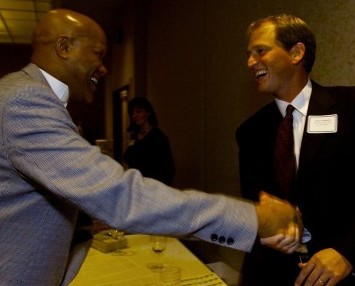
In addition to defeating Neuheisel (by 14 votes), Sasaki upended a slate that included Pac-10 sprint champion JaWarren Hooker, Seahawks receiver Darrell Jackson, Sonics coach Nate McMillan and Emerald Downs riding champion Gallyn Mitchell.
A major leaguer for the first time at 32, the Japanese import had single-handedly put an end to a horrid string of Gasoline Alley bullpens that plagued the Mariners in the late 1990s.
His 37 saves set a major league record for a rookie and broke by four the previous Seattle club record (33, Jose Mesa, 1999). In Rookie of the Year voting, Sasaki received 17 of 28 first-place votes to edge Oakland’s Barry Zito, becoming the first closer to win the award in more than a decade.
Megan Quann became the first swimmer voted Man/Star of the Year since the Colella siblings, Lynn and Rick, won in 1971. She outpolled UW soccer star Tami Bennett (school’s all-time leading scorer), UW basketball star Megan Franza (17.2 ppg) and UW softball pitcher Jennifer Spediacci, a two-time All-America who had become the first in school history to record 100 career wins.
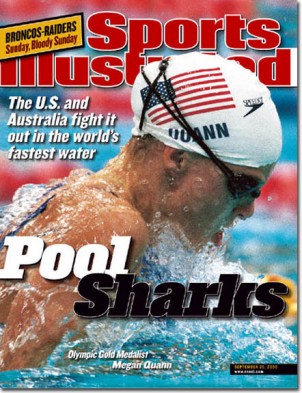
At 17, Quann was the youngest medalist on the 2000 U.S. Olympic team in Sydney, taking a gold medal in the 100 breaststroke and another gold as a member of the USA 400 medley relay team.
Quann, swimming as Meagan Jendrick, missed competing in Athens in 2004, but made her third Olympic team in 2008, winning a silver medal.
She ultimately set 27 American records, four world records, became a 10-time national champion and a 10-time U.S. Open champion.
Quann appeared on the cover of the Sept. 25, 2000 issue of Sports Illustrated, heading for the finish line in her gold medal relay race.
2001 / ICHIRO SUZUKI, Baseball
2001 / JAN HARVILLE, Rowing
No one doubted which athlete would prevail in the 2001 Male Sports Star of the Year vote, the only issue being the size of his landslide. In fact, it became one of the largest since banquet goers began voting in 1974, Ichiro winning by a whopping 334-point margin.
Noted the Post-Intelligencer: “Ichiro’s fellow nominees — UW All-America defensive tackle Larry Tripplett (second-team AP All-America), Seahawk running back Shaun Alexander (1,313 yards, 14 TDS), Sonics guard Brent Barry (NBA-leading .476 percent from 3-point range) and short-track speedskater Apolo Anton Ohno (two golds at the World Championships) — can take heart. Most major league teams fared no better against Ichiro.”
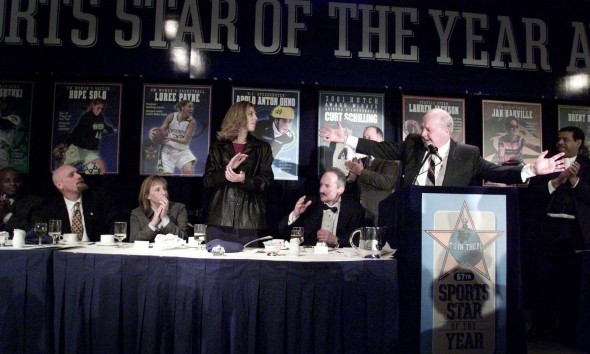
In addition to giving the Mariners their second straight Rookie of the Year winner (Kazuhiro Sasaki in 2000), Ichiro won the AL Most Valuable Player award and led the league in batting (.350 average), becoming the first player in history to claim all three in the same season.
That was just the beginning. In addition to winning the batting title, Ichiro led the AL in stolen bases (56), the first player since Jackie Robinson in 1949 to accomplish that feat. He also set a club record with 242 hits, most in the majors since 1930, and became the third rookie to produce a 200-hit season.
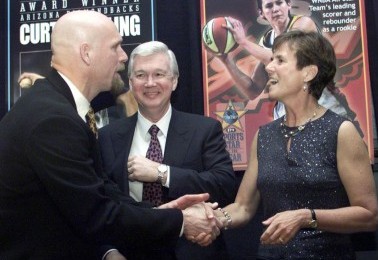
Ichiro also claimed a Gold Glove, a Silver Slugger and represented the 116-win Mariners in the All-Star Game.
Recently retired Mariner Jay Buhner accepted the award on Ichiro’s behalf, receiving rousing applause intended as much for him as for Ichiro, who remained home in Japan.
“It was only fitting,” Buhner, a 1994 Sports Star nominee, joked. “He took my job, so I’m here to accept his award.
“He is the most exciting leadoff hitter in the game. He had just an unimaginable season, and on top of that helped us win 116 games. There are a lot of deserving people here. And I think this shows that Mariner baseball is pretty catchy right now, especially when you put a good product on the field. It wasn’t too long ago we were fighting for the existence of the organization.”
Voting for the 2001 Female Athlete of the Year was as close as its nominees were diverse. Seattle Pacific basketball star Gyongyver Balogh was voted the Pacific West Conferences top player; 6-5 Australian rookie Lauren Jackson of the new Seattle Storm WNBA franchise averaged 15.5 points per game; UW’s Loree Payne topped the women’s basketball team in scoring and led the Huskies into the Elite Eight; and junior goalkeeper Hope Solo posted a Pac-10-best 0.68 goals-against average.
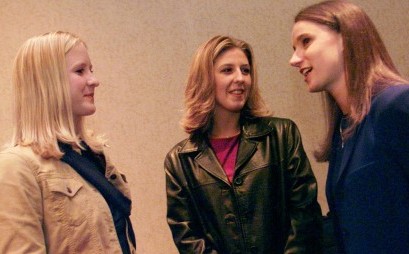
But UW rowing coach Jan Harville prevailed (following her second Star of the Year nomination) after winning her third NCAA championship (1997, 1998, 2001) and her record 10th consecutive Pac-10 title, for which she had already been named Woman of the Year by U.S. Rowing.
“It’s just an honor to be a finalist, really,” said Harville. “It’s always fun to see who else is doing well and for me, as you get a little older, you have a broader perspective. This is a recognition of the success of our program.”
2002 / JAMIE MOYER, Baseball
2002 / SUE BIRD, Basketball
Six of the 10 2002 Sports Star of the Year nominees either had been born or reared in the state of the Washington, but the 670 voters at the Westin Seattle Hotel went for a pair of transplants, Mariners pitcher Jamie Moyer and Seattle Storm guard Sue Bird as the Male and Female Sports Stars of the Year.
Moyer, the overwhelming choice in the men’s division over Olympic gold medalist Apolo Anton Ohno, became the third Mariner winner in a row, and the ninth overall since Ken Griffey Jr. became the franchise’s first SOY in 1989 (see Wayback Machine: Sports Star Of Year, 1980-89).
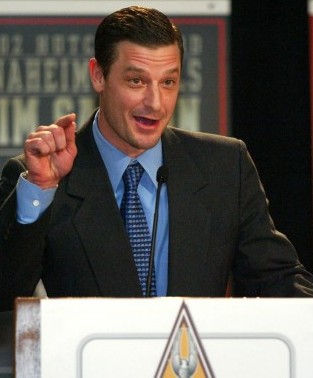
Moyer, oldest of the finalists at 40, had not come close to duplicating the 20-6 record he had in 2001, but he had gone 13-8 and led the Mariners in winning percentage and innings pitched, logging 230.2.
Ohno, the short-track skating celebrity, earned two medals at the Salt Lake City Winter Olympics, a gold in the 1,500 meters and a silver in the 1,000.
Three football players finished far down in the balloting, Seahawks quarterback Matt Hasselbeck (3,075 yards, 15 touchdowns), Washington State’s Outland Trophy winner Rein Long, the first Cougar player nominated since Mike Utley in 1988, and Washington receiver Reggie Williams, whose 94 catches broke Jerome Pathon’s 1997 school record by 21 catches.
Bird’s victory, over UW goalkeeper and two-time finalist Hope Solo, UW rower Anna Mickelson (gold medal in eight at the World Championships) and UW softball star Jamie Clark (led the nation with 75 RBIs), marked the first time that a women’s professional basketball player had earned Sports Star recognition.
In her rookie season, one year removed from leading Connecticut to the NCAA women’s title, Bird, 22, had averaged 14.4 points and 6.0 assists. Unable to attend the Star of the Year banquet due to her participation in winter ball in New England, Bird was represented by Kate Starbird, the 1997 Female Star of the Year.
“She’s an amazing basketball player,” Starbird said. “Her leadership skills and her basketball skills are incredible. She’s only going to improve. This was her first season, and she just did incredible things in the WNBA.”
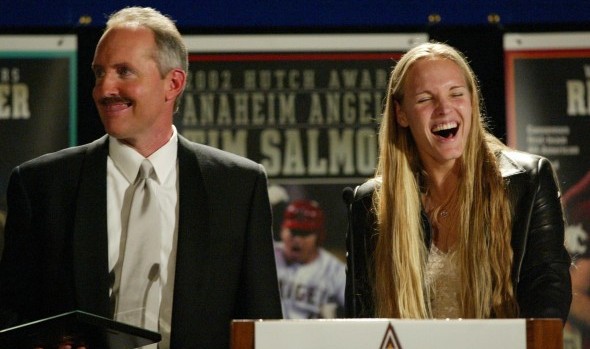
2003 / MATT HASSELBECK, Football
2003 / LAUREN JACKSON, Basketball
Only a few trades in Seahawks history can be classified as heists. But the one Mike Holmgren pulled off March 2, 2001, at the expense of the Green Bay Packers, his former employer, qualifies amply. Holmgren traded Seattle’s first round (10th overall) and third-round (72nd overall) picks for Green Bay’s backup quarterback and its No. 1 pick (17th overall).
That’s how Holmgren obtained three-time Pro Bowler Matt Hasselbeck and guard Steve Hutchinson, who would represent Seattle in four Pro Bowls.
Hasselbeck became the 2003 Male Sports Star of the Year following the first of his three Pro Bowl seasons, in which he threw for 3,841 yards, 26 touchdown passes and directed the Seahawks to their first postseason appearance since 1999.
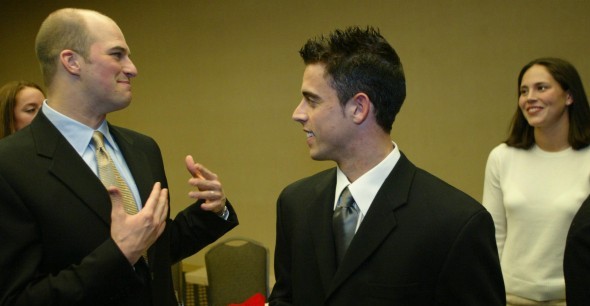
Hasselbeck’s closest competition for Male Star of the Year came from the Mariners All-Star second baseman, Bret Boone, whose 35 home runs figured prominently in the club’s 93 victories, and UW wide receiver Reggie Williams, who had trashed the Husky record book while making himself a first-round NFL draft choice.
The women’s side of the ballot featured three UW athletes, soccer star Tina Frimpong, the school’s all-time leading scorer; Giuliana Mendiola, a basketball player en route to becoming UW’s all-time leading scorer (she dropped a school-record 43 points on UCLA Feb. 2, 2003); and softball player Kristen Rivera, the Pac-10’s co-conference Player of the Year.
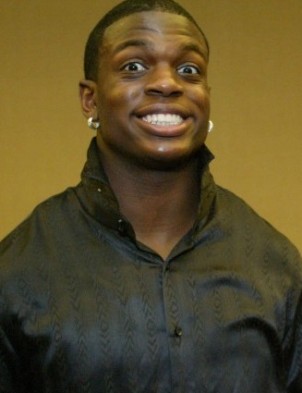
Lauren Jackson of the Storm, on the ballot for the second time (also 2001), easily prevailed in the vote, having established herself as one of the elite basketball players in the world.
Jackson averaged 21.2 points and won the first of three Most Valuable Player awards (also 2007 and 2010).
More significant: combining with point guard Sue Bird, Jackson led Seattle to WNBA titles in 2004 and 2010, the city’s first professional championships since 1979, when the SuperSonics claimed the NBA title.
Interesting about Hasselbeck’s Star of the Year award in terms of the program’s nomination process: Not only did he become the first Seahawks quarterback to win, he became the franchise’s first quarterback nominee since Jim Zorn in 1978 (see Wayback Machine: Sports Star of the Year 1970-79).
2004 / RYAN MOORE, Golf
2004 / ANNE DONOVAN, Basketball
When Post-Intelligencer readers assisted the newspaper in coming up with nominations for the 2004 Star of the Year, many urged the candidacy of Puyallup native Ryan Moore, even though no golfer had won since Anne Quast Decker in 1961, and no male golfer had taken the top prize since Harry Givan in 1945 (see Wayback Machines: Sports Star Of Year 1935-49, 1960-69).
But in the long history of the program, which by 2004 had reached 70 years, no nominee arrived at the head table more deserving: All Moore had done was turn in the best season by an amateur since Bobby Jones dominated the 1930s.
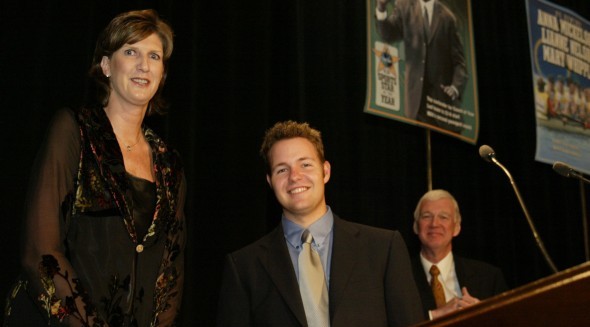
A senior at UNLV, Moore had won the NCAA championship, his second consecutive U.S. Men’s Amateur, the Western Amateur, the U.S. Public Links and the Sahalee Players Championship. Moore also finished 24th at the PGA Tour’s Chrysler Classic, an effort that would have earned him $42,000 if not for his amateur status.
Golf Magazine called Ryan’s the greatest amateur season in the sport’s modern era, and his performances earned Moore invitations to the U.S. Open, British Open and his second Masters.
“It’s tough to put this year into words for me,” Moore told the sold-out house at the downtown Sheraton Hotel.
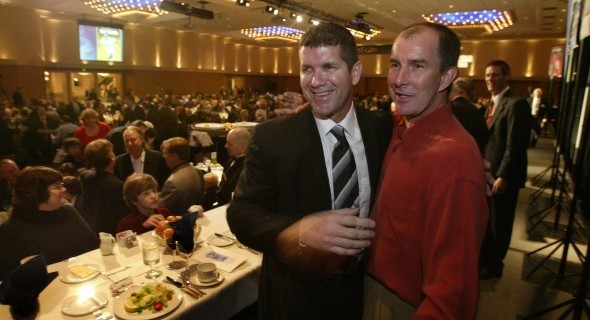
Moore became the first non-professional, non-UW football player to win the men’s award since 1986, when Seattle Pacific soccer coach Cliff McCrath topped the voting. And to underscore just how enamored SOY voters were with him, consider the men’s field:
Shaun Alexander of the Seahawks scored 20 TDs to lead the NFL; Kasey Kahne of Enumclaw was voted the Nextel Rookie of the Year; Nate McMillan coached the Sonics to a Pacific Division title; and Nate Robinson, the Lord of Leap, was named Associated Press All-America after leading the Huskies into the NCAA Basketball Tournament.
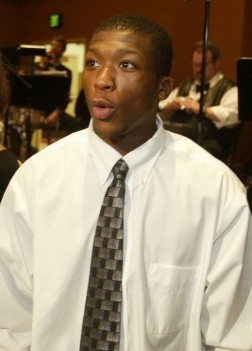
On the women’s side, Storm coach Anne Donovan not only became the first female coach to win a WNBA title, she also served as an assistant for the U.S. national team that captured an Olympic gold medal in Athens.
That gave her a landslide win over a pair of Huskies, Pac-10 soccer Player of the Year Tina Frimpong (set UW records for goals and game-winning goals) and All-America volleyball setter Courtney Thompson (No. 3 in the nation in assists).
Ironically, Anne Quast Sander saw Moore claim the Male Athlete of the Year award after not having attended the Post-Intelligencer banquet in many years.
Prior to the ceremony, the 65-year-old former U.S. Women’s Amateur champion lobbied for a change in the selection format back to the way it had been when Brougham created the Man of the Year awards in 1936.
Over the years, the process had evolved from a poll of P-I readers, to a decision by a tribunal of sports experts, to a vote by attendees at the banquet.
”It’s become a popularity contest,” Sander said. “They should go back to the tribunal. The current format favors professional athletes and collegians in high-profile sports.”
For one round of voting, Ryan Moore proved that wrong.
2005 / SHAUN ALEXANDER, Football
2005 / CHRISTAL MORRISON, Volleyball
Before Sports Star of the Year emcee Steve Raible took the microphone for the 71st awards program, Shaun Alexander dominated conversation among nearly every attendee and rival nominee.
“This is a one-horse race,” said Washington State running back Jerome Harrison, one of 10 finalists for male honors. “I thought I had a good year, and then Shaun did what he did.”
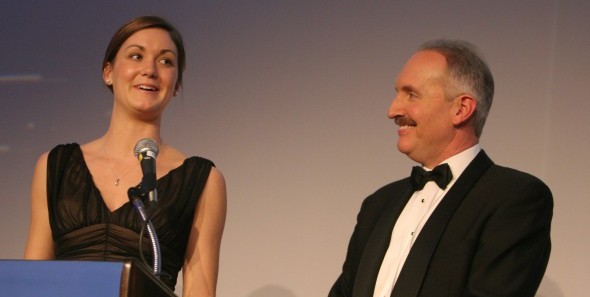
“We aren’t even here,” quipped Mariners closer Eddie Guardado, another finalist. “Just give us a piece of cake and send us home.”
Alexander piled 278 votes to cruise past mountain climber Ed Viesturs (105) and University of Washington basketball coach Lorenzo Romar (100).
Alexander’s 2005 performance — an NFL-leading 1,880 yards and an NFL-record 28 touchdowns — had resulted in him becoming the first Seahawks player named the league’s Most Valuable Player.
Harrison had been an All-America running back at WSU, Guardado a 36-save man for the Mariners, Romar the first UW basketball coach to earn a No. 1 seed to the NCAA Tournament, Ray Allen an NBA All-Star, and Viesturs the first to have summited every 8,000-meter peak in the world. But in the minds of voters, all that paled next to Alexander’s feats for a team he had led to the Super Bowl.
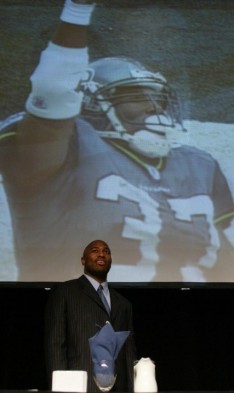
Viesturs, the male runnerup, was the least-known athlete entering the vote, but his inspiring video elicited a sizable ovation and a strong showing in the voting.
With his ascent of Nepal’s 26,500-foot Mount Annapurna the previous May, Viesturs completed a 16-year quest to scale all 14 of the world’s 8,000-meter peaks without supplemental oxygen.
The only surprise of the night — and that a modest one — occurred when Washington volleyball star Christal Morrison beat out sentimental favorite Kayla Burt for the female Star of the Year.
Morrison, who led the Huskies to a national championship, received 265 votes to 182 for Burt, the UW basketball guard who battled through a serious heart condition to lead the Huskies in scoring and assists.
Morrison, who said before receiving her award that she hoped Burt would win, was gracious in victory. “Every individual award is really a team award,” she said. “I’m accepting this on their behalf.”
2006 / BRANDON ROY, Basketball
2006 / COURTNEY THOMPSON, Volleyball
For the first time since the Star of the Year program recognize male and female winners (1994), neither made it to the banquet for an acceptance speech. But both had viable excuses.
Former UW basketball All-America Brandon Roy, a rookie with the Trail Blazers, had an engagement in Portland, where he made the game-winning free throws in an overtime victory over the Minnesota Timberwolves. Roy’s father, Tony, accepted on behalf of his son.
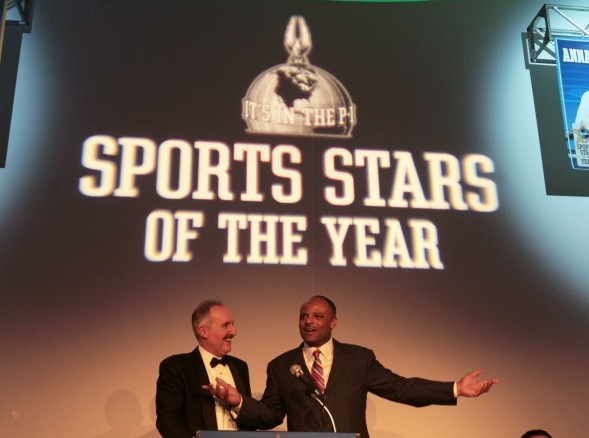
“Oh my, the ride continues,” said Tony, addressing banquet goers. “It’s been so fun, so great.”
Roy, the 2006 Pac-10 Player of the Year, led the Huskies to the NCAA Tournament’s Sweet Sixteen. In winning the Male Star of the Year, he became the first UW men’s basketball player so recognized, and the first college basketball player to win since Elgin Baylor of Seattle U. in 1958 (see Wayback Machine: Sports Star Of Year 1950-59).
“Looking back on it, we can’t describe it,” Tony Roy said. “The reception he gets at home is amazing, because home means so much to him. To get this kind of recognition is really great.”
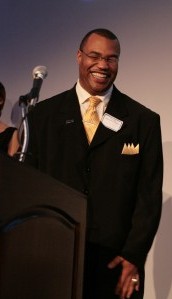
In four UW seasons, Roy helped the Huskies to three consecutive NCAA Tournaments, a Pac-10 tournament title, and capped it as a senior by earning first-team All-America honors en route to becoming a lottery selection in the NBA draft.
Roy, a Garfield High graduate, and Thompson, a Kentlake product, gave the UW its first double win since 1999 when quarterback Marques Tuiasosopo and softball star Becky Newbry won.
Thompson capped her career by leading UW to its third consecutive Final Four. As a junior, Thompson helped lead the Huskies to their first national title and also earned the Honda Award, given to the nation’s best player. Thompson could not attend the banquet because she was training with the U.S. national team.
“I’m bummed Courtney couldn’t be here,” Morrison said. “This is such an amazing award and I just think if she was here, she would be so thrilled about it.”
The 72nd edition of the program drew a number of prior winners, including Jim McCurdy (1944), Johnny O’Brien (1952), Don McKeta (1960), Brian Sternberg (1963), Doris Brown Heritage (1970), Rick Colella (1971), Tom Gorman (1972), Slick Watts (1976) and Cliff McCrath (1986).
But none attracted more attention than 1956 winner Pete Rademacher. The former WSU football player won a boxing gold at the 1956 Olympics as a heavyweight and became the first to make his pro debut in a championship fight, earning a 1957 bout with then-heavyweight champion Floyd Patterson, losing in six rounds at Sicks’ Stadium.
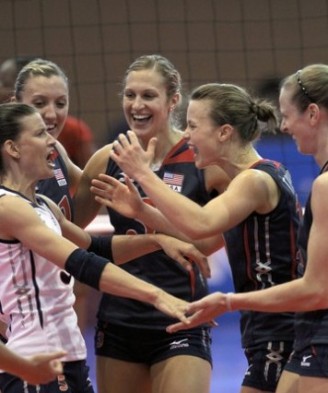
Rademacher flew in from his home in Medina, OH., a little more than a week after Margaret, his wife of 53 years, died.
Post-Intelligencer publisher Roger Oglesby also presented another former winner, 1977 honoree Warren Moon, with The Publisher’s Award, honoring his long pro career. Moon used the occasion to recall his P-I award three decades earlier.
“I was up against a horse — Seattle Slew,” Moon said. “I thought I had a good chance to win. I was here. I had an acceptance speech. I thought I had an advantage.”
2007 / BOBBY ENGRAM, Football
2007 / DANIELLE LAWRIE, Softball
If voters at the 73rd SOY program had cast their ballots for the most extreme sports athlete under consideration, distance runner Scott Jurek would have won easily. In fact, labeling Jurek a distance runner did him an injustice.
An ultra-marathoner, Jurek had won his second consecutive Sportathlon, covering 153 miles in 23 hours, 12 minutes. He also won the Hardrock 100, at altitudes of 7,700 to more than 14,000 feet, in a record time of 26:08. Jurek also won seven successive Western States 100s.
But Jurek couldn’t overcome the larger athletic profile that belonged to 34-year-old wide receiver Bobby Engram.
Engram not only surprised Seahawks fans, but himself, by coming back from a serious medical problem — Graves disease, a thyroid condition — to set a team record with 94 catches (1,147 yards), breaking Darrell Jackson’s previous record of 87 set in 2004.
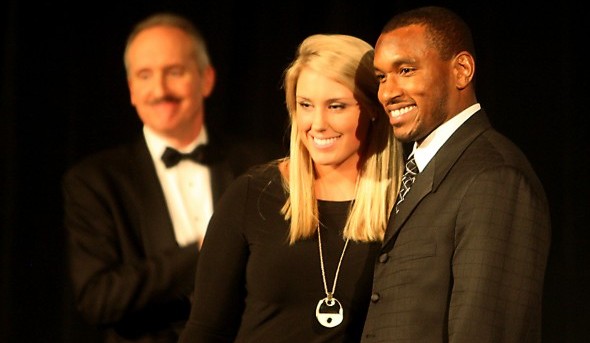
“Basically I had my health and my career snatched from my grasp in about two or three weeks,” Engram said. “It was a blessing, though at the time I didn’t see it. It’s really helped me as a person, and it’s helped me tremendously as a player. When you’re down you have to look up, and that’s what I did last year. This is very gratifying on many levels.”
The men’s vote was close, with J.J. Putz, the Mariners’ All-Star closer, and Jon Brockman, UW’s All-Pac-10 basketball forward, tying for second behind Engram.
A 20-year-old sophomore, Washington’s Danielle Lawrie broke her own school record with 457 strikeouts — an amazing 14.8 per nine innings. Lawrie went 31-13 and led the Huskies back to the College Softball World Series, where she opened the tournament with a no-hitter and a one-hitter.
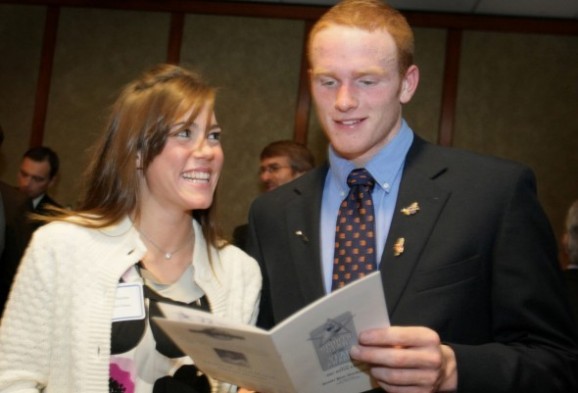
“What an honor, just to be nominated for this,” Lawrie said. “I’ve got my family here and my coaches. It’s pretty special.”
Lawrie had been selected a first-team Louisville Slugger/NFCA All-America, named to the Women’s College World Series All-Tournament Team and was the first-team All-Pac-10 pitcher. After just two years, she moved into second place on Washington’s career strikeout list with 844.
Other women’s honorees included second-place finisher Sarah Martinez of Seattle Pacific University, an NCAA Division II first-team soccer All-American who set conference records for goals and points; SPU runner Jessica Pixler, who won the NCAA Division II cross-country title and a gold medal at the Junior Pan Am Games; and UW crew coxswain Katelin Snyder, who guided the men’s varsity eight through an unbeaten season that ended with the program’s first national championship in 10 years.
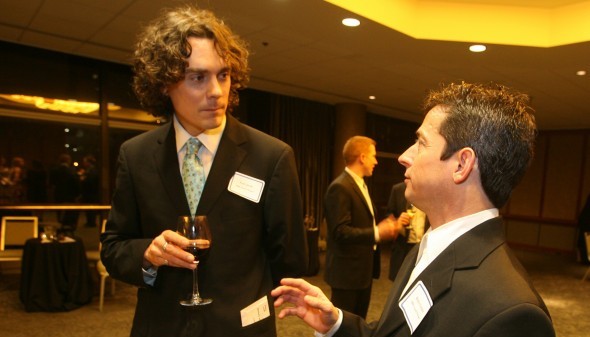
2008 / JON BROCKMAN, Basketball
2008 / HOPE SOLO, Soccer
Convinced that the Star of the Year program had reached its end (due to the imminent closure of the Post-Intelligencer), the newspaper had this to say in announcing the 2008 winners.
“Eight of the first 10 were affiliated with University of Washington sports,” the newspaper wrote. “So it’s fitting that perhaps the last two people to take home the award would be Huskies.”
UW forward Jon Brockman, who set the school rebounding record, and former soccer goalkeeper Hope Solo, who won a gold medal with the USA team at the Olympic Games in Beijing, became the honorees.
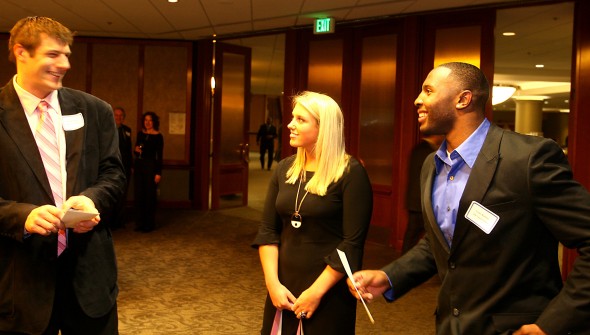
A senior from Snohomish, Brockman led the Pac-10 in rebounding for two consecutive years and was All-Pac-10 both seasons. A week earlier, he snatched 10 rebounds against Oregon, giving him 1,054 and pushing him past the 50-year-old career mark of Doug Smart.
“In basketball, you can’t do anything on your own,” Brockman said. “I couldn’t do it without my teammates. But the record is something that, as I get older and people start forgetting, I can convince my kids that I was a good basketball player.”
For Solo, 2008 had been a year of redemption. She was benched in World Cup competition in 2007, spoke out and was criticized by teammates. But a year later, at the helm of the national team, she withstood a withering attack by Brazil in the Olympic gold medal match as the U.S. earned a 1-0 overtime victory. She was named player of the match.
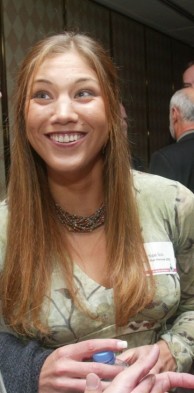
“That’s amazing, just incredible,” said Solo by phone from Los Angeles, where she was in training with the national team.
“I’ve had a lot of recognition and some awards, but this one means a lot. I’ve been a longtime P-I reader and advocate, and my dad (Jeffrey, who passed away in 2007) always wanted me to win this award. It’s very cool.”
Brockman prevailed over a nominee list that included WSU hurdler Jeshua Anderson; nine-time Pro Bowl tackle Walter Jones; USC safety and O’Dea product Taylor Mays; and San Francisco Giants pitcher Tim Lincecum, a UW product who won the National League Cy Young Award.
Solo won over a slate that included SPU soccer player Meredith Teague, the NCAA Division II national player of the year; Jennifer Whitaker, the first female jockey to win the Longacres Mile; Olympic gold medal rowers Anna Cummins and Mary Whipple; and the national champion UW cross country team.
2009 / FELIX HERNANDEZ, Pro Athlete
2009/ JAKE LOCKER, Male Athlete
2009 / UW SOFTBALL TEAM, Female Athlete
For the 2009 Star of the Year awards, the Seattle Sports Commission added some new voting catgories, most notably the Professional Sports Star of the Year, which offered male and female nominees, including Storm All-Star Swin Cash; David Hawthorne, the Seahawks leading tackler; Mariners ace Felix Hernandez, Sounders FC captain and goalkeeper Kasey Keller and NASCAR truck star Tayler Malsam.
Hernandez, who won an AL-high 19 games, was a predictable winner. And, because he was competing in his own category, he didn’t send UW quarterback Jake Locker home a loser.
Locker, the first Husky quarterback honored since Marques Tuiasosopo in 1999, emerged as an easy winner after facing off against Washington’s Lorenzo Romar, the 2009 Pac-10 Coach of the Year; Husky golfer Nick Taylor, who lit up the amateur ranks; and the UW men’s varsity eight, fresh from winning another national championship.
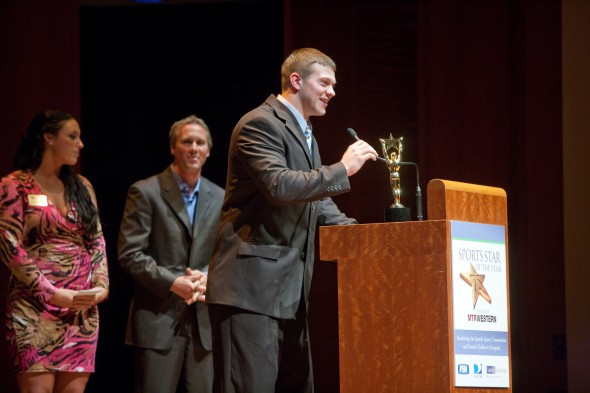
The Female Star of the Year field included the national champion UW softball team; Washington cross country star Kendra Schaaf, who won the Canadian National Championship and finished second at the NCAA Cross Country Championships; Seattle Pacific’s Jessica Pixler, winner of eight NCAA Division II running titles; Washington libero Tamari Miyashiro, a second-team AVCA All-American; and Michelle French, a midfielder for the Sounders women’s team.
Thanks to Danielle Lawrie (2007 Female Star of the Year) and her magnificent pitching, the UW softball team was deemed the year’s best. UW softballers also won another new category, Play of the Year, for their winning moment at the College World Series in Oklahoma City.
The toughest decision voters had to make: deciding on the Best Sports Story of the past 75 years, another Sports Commission idea. The nominees ran the gamut:
- Fred Hutchinson’s 19th win on his 19th birthday in 1938 for the Seattle Rainiers.
- Elgin Baylor (1958 Man of Year) and Seattle University reaching the NCAA Tournament final opposite Kentucky in 1958.
- The Washington crew’s upset of Leningrad’s famed Trud Club in Moscow in 1958.
- Washington football’s 1977 Rose Bowl victory over Michigan.
- The Seattle SuperSonics’ 1979 NBA championship.
- The University of Washington football team’s 1991 co-national championship.
- The 1995 Seattle Mariners, who won their first AL West championship.
- The Storm’s 2004 WNBA championship.
- The Seahawks’ run to the Super Bowl in 2005.
- The Sounders FC inaugural season of 2009.
Man of the Year founder Royal Brougham, who covered the race for the Post-Intelligencer, would not have been surprised that Star of the Year voters went for Al Ulbrickson’s 1958 crew. But Brougham, who died in 1978, would have shocked to learn that 30,000 individuals had voted online to determine the winners of his little clambake.
2010 / TIM LINCECUM, Pro Athlete
2010/ APOLO OHNO, Male Athlete
2010 / JESSICA PIXLER, Female Athlete
When Tim Lincecum became a nominee for the Pro Athlete of the Year at the 76th annual Sports Star of the Year awards banquet (second time nominated), he was already a two-time National League Cy Young Award winner, a two-time Sporting News Major League Pitcher of the Year and a three-time National League strikeout champion. He had formidable competition for the program’s Pro Athlete of the Year award, but none he couldn’t dispatch easily.
Swin Cash of the Storm had made the WNBA All-Star team and helped her team win a second league championship (previous winners Sue Bird and Lauren Jackson were ineligible); forward Fredy Montero of the Sounders had led his club in nearly every statistical category, including goals with 10, assists (10), shots (91), shots on goal (34), fouls called (44) and fouls suffered (60); Lewis Ratcliffe of the new Washington Stealth had led the National Lacrosse League in scoring (46 goals); and Mike Williams, a Seahawks receiver, had made a remarkable career comeback to catch 65 passes for 751 yards and two touchdowns.
Lincecum, unable to attend the awards show, won as easily in his category as short-track speedskater Anton Apolo Ohno did in his, Male Athlete of the Year. Ohno collected three more medals in the 2010 Vancouver Winter Olympics, hiking his career total to eight, most in U.S. history by a Winter Olympian.
Ohno prevailed over a field that included short-track teammate J.R. Celski, University of Washington linebacker Mason Foster, UW basketball star Quincy Pondexter, and Washington State basketball star Klay Thompson.
Pondexter made a compelling case for the award after finishing his career as the No. 3 scorer in UW history and winding up second in the voting for Pac-10 Player of the Year. But Ohno’s Olympic celebrity was too much to overcome.
Jessica Pixler, the former Seattle Pacific runner, dominated the vote for Female Athlete of the Year after winning the NCAA Division II indoor mile in March and the 1,500 meters at the NCAA outdoor meet in May, giving her 12 national crowns overall.
Pixler defeated a field that included UW distance runner Katie Follett, an eight-time All-Amrican; UW volleyball star Jenna Hagglund, a two-time All-American; USA national team swimmer Ariana Kukors, the world record holder in the 200 individual medley; and Karen Thatcher, who had helped lead the USA women’s hockey team to a silver medal in the Vancouver Olympics.

2011 / KASEY KELLER, Pro Athlete
2011 / CHRIS POLK, Male Athlete
2011 / COURTNEY VANDERSLOOT, Female Athlete
Given the staggering popularity of the Seattle Sounders, it came as no surprise that banquet voters went for retiring goalkeeper Kasey Keller in a big way as Pro Athlete of the Year. But Keller’s selection had as much to do with his athletic exploits as it did with sentiment.
A native of Olympia, Keller led the Sounders to their third consecutive U.S. Open Cup victory in 2011. He also earned the MLS Goalkeeper of the Year award and Best XI honors in the final year of a career for one of America’s all-time best keepers. Prior to joining the Sounders, Keller played in Europe while accumulating U.S. National Team goalkeeping career records for most caps (102), wins (53) and shutouts (47).
He also played in three of the world’s top leagues: England’s Premiership, Spain’s La Liga and Germany’s Bundesliga. During his European career, Keller spent four years with Millwall (1992-96), three years with Leicester City (1996-99), four years with Tottenham Hotspur (2001-05), and two years with Borussia Monchengladbach (Germany).
Any one of his competitors for Pro Athlete of the Year would have been superb choices. Mariners closer Brandon League saved 37 games and made his first American League All-Star team; Jason Terry, a Franklin High grad, helped lead the Dallas Mavericks to the NBA title; Seahawks safety Earl Thomas made his first Pro Bowl, and hydroplane driver Dave Villwock surpassed Bill Muncey as the most successful boat pilot in the sport’s history.
Male Athlete of the Year Chris Polk finished his University of Washington career as the No. 2 rusher in school history with 4,049 yards, just 57 behind 1994 Star of the Year Napoleon Kaufman. Polk joined Kaufman as the only runners in school history to post three consecutive 1,000-yard seasons, set a UW record by rushing for 100 or more yards in 21 games and became the only back in school history to average more than 100 rushing yards per game in a single season.
Polk beat out two fellow Huskies, basketball player Isaiah Thomas and golfer Chris Williams, as well as Washington State track star Jeshua Anderson, and Bremerton swimmer Nathan Adrian, a star of the U.S. national team.
Female athlete of the year went to Gonzaga guard Courtney Vandersloot, absent from the program because she was playing professionally in Istanbul. Her award was Gonzaga’s first.
A graduate of Kentwood High, Vandersloot led the Gonzaga women’s team to a 31-5 record and a trip to the Elite Eight in the 2011 NCAA Tournament. Much decorated, Vandersloot was the only player in West Coast Conference history selected league Player of the Year three times (2009-11) and the only player in the history of the conference named WCC Tournament Most Valuable Player three times (2009-11).
Sports Story of the Year went to the FCS National Champion Eastern Washington football team. Quarterback Bo Levi Mitchell led the Eagles to a 20-19 championship game win over Delaware.
The Seattle Sports Commission also honored longtime broadcaster Bob Robertson with the Keith Jackson award, named Gary Wright of the Sounders the Sports Executive of the Year, Detlef Schrempf Sports Citizen of the Year, and Bob Houbregs the Royal Brougham Legend award winner.
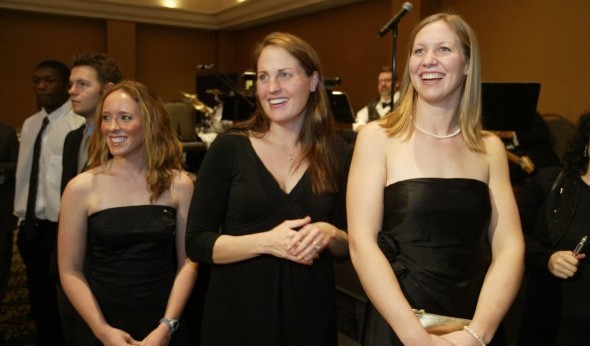
——————————————–
ALSO SEE
Man Of The Year Winners (1935-76)
Star Of The Year Winners (1977-2011)
Wayback Machine: Sports Star Of Year (1935-49)
Wayback Machine: Sports Star Of Year (1950-59)
Wayback Machine: Sports Star Of Year (1960-69)
Wayback Machine: Sports Star Of Year (1970-79)
Wayback Machine: Sports Star Of Year (1980-89)
Wayback Machine: Sports Star Of Year (1990-99)
——————————————-
Many of the historic images published on Sportspress Northwest are provided by resident Northwest sports history aficionado David Eskenazi.Check out Davids Wayback Machine Archive. David can be reached at (206) 441-1900, or at seattlesportshistory@gmail.com
——————————————
 The The MTR Western Seattle Sports Star of the Year awards program is at Benaroya Hall Friday. Created by Royal Brougham and the Seattle Post-Intelligencer in 1936 and currently presented by the Seattle Sports Commission, the MTR Western Star of the Year recognizes professional and amateur athletic achievement. Tickets can be purchased at benaroyahall.org or by calling 206-215-4747. The top-priced ticket includes admission to the show and the reception where complimentary beverages, including beer and wine, and heavy appetizers will be provided. You can find more information here.
The The MTR Western Seattle Sports Star of the Year awards program is at Benaroya Hall Friday. Created by Royal Brougham and the Seattle Post-Intelligencer in 1936 and currently presented by the Seattle Sports Commission, the MTR Western Star of the Year recognizes professional and amateur athletic achievement. Tickets can be purchased at benaroyahall.org or by calling 206-215-4747. The top-priced ticket includes admission to the show and the reception where complimentary beverages, including beer and wine, and heavy appetizers will be provided. You can find more information here.

4 Comments
Slick Watts – not Watt
Slick Watts – not Watt
You can see some of the evolution of Seattle’s weirdness, or, I mean our beauty and correctness in all things the future, in some of the 2000-2011 montage.
No idea what you’re talking about, but OK.